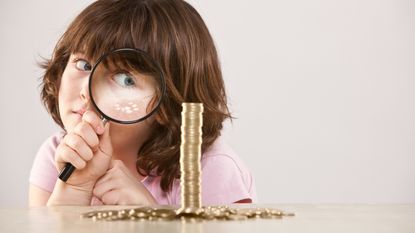How Parents Can Teach Their Kids About Cryptocurrency
Starting with explaining the concept of money to begin with can help them grasp the concept of digital currencies.


There is so much to cover on the topic of how cryptocurrency and NFTs, or non-fungible tokens, will affect the next generation of investors that I’m going to devote two articles to it. The second article, How Parents Can Explain to Kids How NFTs Work, published in January. This first article focuses on kids and cryptocurrency, specifically how parents can teach and introduce their offspring to the new world of digital assets … their future.
Before I get into if or when you should start to introduce kids and grandkids to crypto and other digital products, I’ll give you some background.
The New World
Your world is only a click away. Your phone and computer connect you to others and to the world in a way that is now the new normal. We stay in touch with friends; we run our businesses; we network with companies; we play games; we watch goofy videos and share them; we buy and sell every product and service imaginable; we pay bills and transfer money; and we buy and sell art and collectibles.

Sign up for Kiplinger’s Free E-Newsletters
Profit and prosper with the best of expert advice on investing, taxes, retirement, personal finance and more - straight to your e-mail.
Profit and prosper with the best of expert advice - straight to your e-mail.
Smartphones are part of our life. In the U.S., there are 294.2 million smartphone users (the number is 6.6 billion globally). 85% of American adults use smartphones. And what is interesting is that 47% of U.S. users say they couldn’t live without their devices.
Our Next Generation
NPR reports that over half of the children in our country own a smartphone by the age of 11. This does not include smartphone use by children whose parents hand over their devices. Younger kids are playing video games, and older teens are not only gaming, but are also knee-deep in social media, texting, clicking on YouTube, TikTok and other sites. In fact, EdSource.org reported that children 8 years old and younger spend at least 48 minutes per day on a mobile device.
The numbers show us that the digital world is part of the world. Games and social media are one thing to understand, but I think many of the older generations are flummoxed by the thought of digital money and digital art. I recommend that parents try to understand this new world and educate your kids, rather than hide your head in the sand.
Let’s begin with the basics of the evolution of money as a medium of exchange.
Why Money Was Invented
Once upon a time about 10,000 years ago, people lived where they could easily move from place to place to find food. When one group of people met another group, they would sometimes see new things they wanted, which led to bartering among the groups to exchange goods and services.
Bartering quickly got complicated because it became too hard to figure out the value of things. You can only tell the value or worth of something by knowing what people are willing to give you in exchange for what you have or the service you can perform. So people began to use a medium of exchange, or a common measure of value. For instance, if shells were used as a common medium of exchange, the value of everything was measured in shells.
People soon found out that they needed to control the supply of the mediums of exchange to make everything work. Precious metals, like gold and silver, were hard to find and could be controlled by rulers or countries, so these became good mediums of exchange. The value could be stamped on these first coins to let everyone know their value.
Before You Morph into the Digital World
The new digital world is important, but I feel strongly that you need to start your child’s financial education with physical money. Pay little kids in coins and bills when they complete their allowance chores or when you give them money. Then go to the bank and open joint savings and checking accounts with them.
When you get home, show them how their accounts are now online. Their money becomes digital, but they saw that it was real before it became digital. They need to start to understand the difference between “video game money” and real money.
The next step is help kids to learn how they can spend their money with a debit card, which is digital money. This is a great way to put “training wheels” on their first financial vehicle.
The educational process has to continue. I spoke to Johnson Cook, co-founder and president of Greenlight, a family fintech company. (I’m an adviser to Greenlight.) Cook told me, “We recommend that parents start young and actively engage with their kids about money. First, kids should learn the basics of money management — how to earn and save — and then advance to investing from there. It’s important for kids to learn financial responsibility by using real financial tools. Our debit card and banking app are a great way to start a lifetime of money lessons.”
Fast-Forward into the Digital World
Now for the fun part. Remind your kids that a medium of exchange is anything that people agree to use to buy and sell goods or services. Also, explain to them that now when you use a debit card, credit card or PayPal, you are using digital cash. You are not paying for everything you buy with a pile of bills and coins. A few years ago, digital money called cryptocurrency also became a medium of exchange, a new currency for people to buy and sell things only in the digital world.
When people first experimented to see which mediums of exchange would work the best, some of the things they tried were feathers, pinecones, dog teeth, the bristles from wild boars, shells, axes and, my favorite, dead rats! You can imagine that most of these didn’t get the job done.
Similarly, there are lots of different cryptocurrencies. One big difference between the ancient money and crypto today is that the crypto and blockchain worlds aren’t controlled by anyone. In the olden times, as in today, the rulers or governments controlled money. With crypto, everyone can see all of the “money” that is created and bought and sold on a public ledger that people call the blockchain.
Another big difference between cryptocurrency and conventional currency is that the value for the purchase or sale of something goes directly to the person's digital wallet, rather than filtering through the banking system, like it does with credit and debit card purchases.
Also, remember how people long ago had to decide the value of something based on what other people were willing to give them in exchange for their goods or services in the marketplace? Cryptocurrencies work the same way — their value will go up and down based upon different economic and market perceptions, plus supply and demand.
Just like you have a wallet for your bills, coins and cards, with cryptocurrency, you have a digital wallet that requires you to have your own secret password, or private key. You use that digital wallet each time you buy or sell something using cryptocurrency.
Should You Buy Cryptocurrency?
I don’t give investing advice. Cryptocurrency values can fluctuate, just like any asset or currency. For instance, Bitcoin, the most famous cryptocurrency, was introduced about 10 years ago. Its value at release was a fraction of a dollar. By 2011, it reached parity with the dollar, meaning one bitcoin was worth a little more than $1. In November 2021, it soared to an all-time trading high of more than $68,000 per Bitcoin. Today, the price is less than $20,000.
These wild swings create risk. But, if you are young and have time on your side, a small part of your investment portfolio could certainly contain cryptocurrency. My big word of warning is not to become a day trader in crypto or, frankly, in any investment asset. Day traders follow the market and try to outguess the swings. The problem is that it is really hard to time the market and get in front of the swings. The majority of day traders lose money.
Kids and Cryptocurrency
Your financial literacy lessons for your kids should include crypto lessons. Start with the history, letting kids research and explain it back to you. Technically, kids can own cryptocurrency; there is no legal age restriction. However, in practice, some of the cryptocurrency exchanges have a minimum age of 18 to buy it.
Challenge kids to answer such questions as:
- What is crypto?
- How can it be used?
- How do you buy it?
- What is a blockchain?
- What is your digital wallet, and how does it work?
You can think of more questions.
Victor Wang, CEO of Stockpile, told me, “You should think about getting your kids involved in crypto investing, which is why we are offering it as an investment alternative on our platform.” He quipped, “A famous marathoner once said that ‘the hardest part of any run is the trip from the bed to the floor.’ One reason we are offering crypto to kids and parents is that they want it. 55% of kids in a recent survey have an active interest in crypto investing. Financial literacy is one thing; financial experience is quite another.”
The exciting part is that you and your child can put a toe in the water to learn and earn together.
And you may want to keep this Ralph Waldo Emerson quote in mind: “Don’t be too timid and squeamish about your actions. All life is an experiment. The more experiments you make the better.”
This article was written by and presents the views of our contributing adviser, not the Kiplinger editorial staff. You can check adviser records with the SEC or with FINRA.

Neale Godfrey is a New York Times #1 best-selling author of 27 books, which empower families (and their kids and grandkids) to take charge of their financial lives. Godfrey started her journey with The Chase Manhattan Bank, joining as one of the first female executives, and later became president of The First Women's Bank and founder of The First Children's Bank. Neale pioneered the topic of "kids and money," which took off after her 13 appearances on "The Oprah Winfrey Show." www.nealegodfrey.com
-
-
 Time to Book a Trip: Prices for Vacation Rental Homes Are Dropping
Time to Book a Trip: Prices for Vacation Rental Homes Are DroppingBook a vacation rental home as prices drop amidst rising interest in hotels. Here's how booking a rental can save you money on your accommodations.
By Becca van Sambeck • Published
-
 Congress Examines Nonprofit Hospital Tax Exemption Kiplinger Tax Letter
Congress Examines Nonprofit Hospital Tax Exemption Kiplinger Tax LetterTax Letter Providing community benefit is just one of many requirements.
By Joy Taylor • Published
-
 Five Ways to Get Key Employees to Ride Out Big Changes
Five Ways to Get Key Employees to Ride Out Big ChangesBusiness transitions can be difficult on workers, but company owners can take steps to incentivize key employees to stick around during times of change.
By Kris Maksimovich, AIF®, CRPC®, CPFA®, CRC® • Published
-
 Are You Overlooking Your Most Valuable Retirement Asset?
Are You Overlooking Your Most Valuable Retirement Asset?Selling your home and relocating could become a bigger part of the retirement conversation, given how real estate markets have boomed over the last decade.
By Julie Virta, CFP®, CFA, CTFA • Published
-
 Insuring Your Plan for Retirement Income
Insuring Your Plan for Retirement Income‘Longevity insurance’ ensures you don’t run out of money in retirement. How to figure out how much you need, the types of annuities to use and when the income should kick in are tricky questions, though.
By Jerry Golden, Investment Adviser Representative • Published
-
 Pros and Cons of Fixed Index Annuities as Retirement Tools
Pros and Cons of Fixed Index Annuities as Retirement ToolsWith so many FIA products available, each with its own contract terms and varying rates, it's crucial to invest in one that fits your retirement plan.
By Cliff Ambrose • Published
-
 Retirement Planning with Life Insurance
Retirement Planning with Life InsuranceAn indexed universal life insurance policy can help you with tax mitigation and extra retirement income in addition to death benefits for your beneficiaries.
By Mike Decker • Published
-
 Which Retirement Accounts Should You Withdraw From First?
Which Retirement Accounts Should You Withdraw From First?Here’s a standard order for when you should tap which account when you’re in retirement.
By Evan T. Beach, CFP®, AWMA® • Published
-
 Nervous About the Markets and Economy? Consider History
Nervous About the Markets and Economy? Consider HistoryTo put things in perspective, focus on what you can control and remember that the ups and downs of the markets and economy can be cyclical.
By Erin Wood, CFP®, CRPC®, FBSⓇ • Published
-
 Expecting a Recession? Seven Steps to Help You Power Through
Expecting a Recession? Seven Steps to Help You Power ThroughInstead of panicking, consider opportunities to add flexibility and resilience to your financial position. These steps can help you enter a potential recession from a position of strength.
By Christian Mitchell • Published









